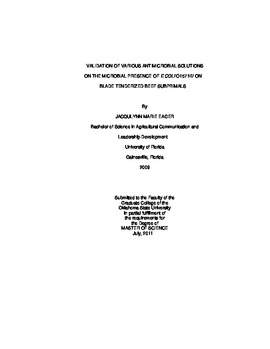| dc.description.abstract | The purpose of this study was to determine the effectiveness of seven proven effective antimicrobial intervention strategies (AvGard V XP, Stabilized NA- Chlorite, Cytoguard Plus, Lactic Acid FCC 88%, AFTEC 3000, Citrilow, and HB2) to control the presence E. coli O157:H7 in mechanically tenderized beef subprimals. Boneless top sirloin beef subprimals cap off (IMPS #169) were inoculated on the lean side with 2 X 104 CFU/cm2 of a four-strain rifamycin-resistant cocktail of Escherichia coli O157:H7 and passed once, lean side up, through a blade tenderizer. Inoculated subprimals that were water sprayed without tenderization served as the negative control and inoculated subprimals that were water sprayed with tenderization served as the positive control. Four core samples (20.25 cm2) were obtained from each subprimal and cut into four consecutive 2.54 cm sections: sections A and B comprised the top 5.08 cm and sections C and D comprised the deepest 5.08 cm. The recovered cores were passed through an Infrared Grill (211.0,,aC at 5 hz) to further eliminate surface contamination. After aseptic separation into A, B, C, and D sections, each individual core section was blended at a volume of 2.5:1 with enrichment broth and incubated for 18 h at 37,,aC. After incubation 1 ml of the blended samples was extracted with E. coli specific immunomagnetic beads, allowing for selective recovery. The entire amount of recovered immunomagentic beads was plated onto Levines eosin methylene blue agar containing 10 f g/ml Rifamycin. Presence of E coli O157:H7 (positive or negative) was recorded for each individual core section (A-D). In section A, AvGard-XP was more effective (P < 0.05) at reducing microbial presence then AFTEC 3000, HB2, and Stabilized NA-Chlorite. Section B revealed that AvGard-XP was more effective at reducing microbial presence then Lactic Acid, AFTEC 3000, HB2, and Stabilized Na- Chlorite. From segment C, AvGard-XP, Citrilow, Cytoguard Plus, Lactic Acid, and AFTEC 3000 were the most effecive (P < 0.05) for the reduction of microbial presence when compared to W+BT. In section D no differences were observed (P > 0.05) between AvGard-XP, Cytoguard Plus, Citrilow, Lactic Acid, AFTEC 3000, HB2, and Stabilized NA-Chlorite. The positive controls (W+BT) consistently showed the highest microbial presence across sections. Similarly, the negative controls (W-BT) consistently showed the lowest microbial presence across sections. | |
